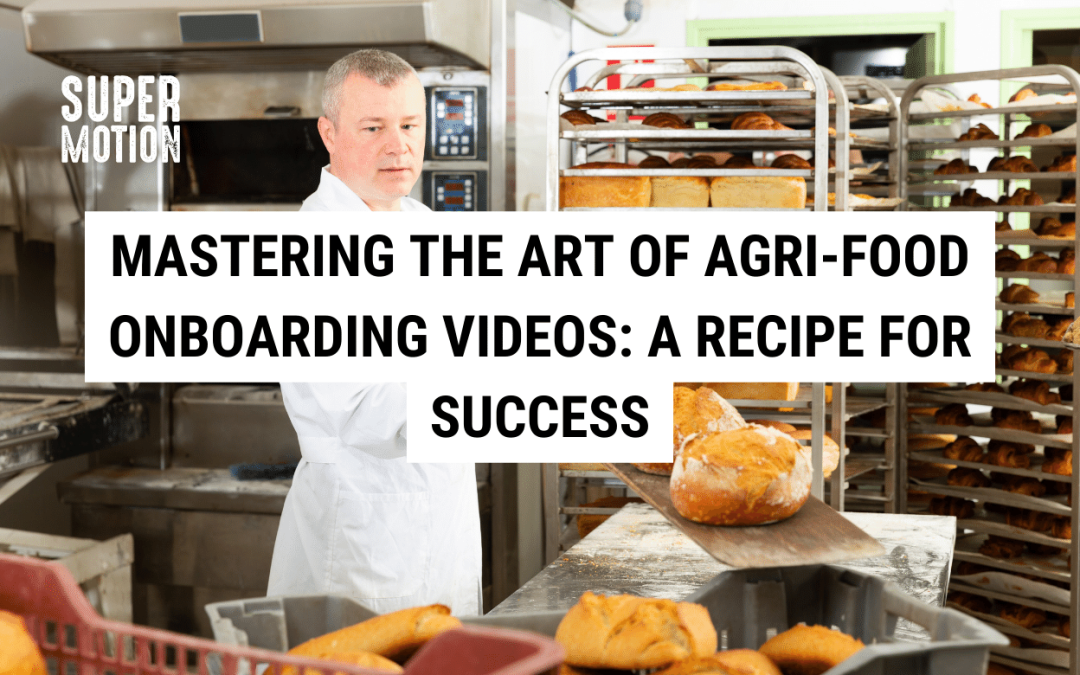
Mastering The Art of Agri-Food Onboarding Videos: A Recipe for Success
Mastering The Art of Agri-Food Onboarding Videos: A Recipe for Success
An effective onboarding process is crucial for new employees, shaping their first impression of the company and aiding their integration. It communicates key information and fosters a sense of belonging and purpose. For Agri-Foods HR Managers, it’s vital for seamless induction and retention in a sector where human resources are pivotal for success.
In the agri-food industry, a cohesive workforce is essential. Crafting an onboarding video that aligns new hires with the company’s purpose is key. As experienced video production experts in the Agri-Food sector, we offer insights on creating an onboarding video that educates, motivates, and integrates effectively.
Cultivating Company Culture on Screen
The roots of an onboarding video lie in the values that your agrarian or food processing enterprise holds dear. It’s not just what you do but why you do it that needs to shine through the screen. Illustrating your commitment to sustainability, quality, and community support can be a pivotal motivator for new employees.
Consider:
- Visually Compelling Storytelling: Weave a narrative that showcases your company’s history, growth, and future vision through impactful visuals whether it’s a farm-to-fork journey or the lifecycle of a product.
- Testimonials and Real Stories: Feature employees across all levels, sharing how they contribute to the bigger picture. This human connection solidifies belief in the company’s ethos.
- Interactive Elements: Quiz segments or challenges can foster an active, not passive, learning environment.
Does Your Video Nourish Cultural Understanding?
To engage with employees from diverse backgrounds, you need a video that transcends language barriers and speaks to the heart of your culture.
Is it evident in your onboarding materials which ethical principles and farming philosophies your company holds dear, and how they come to life in day-to-day operations?

Role Clarity in the Production Spotlight
An onboarding video should leave no new recruit in the dark about their specific contributions to your organisation. It’s essential that your onboarding video helps them to understand how their role and the processes they’re responsible for, fit into the successful operation of your business.
Here’s how you can ensure clarity:
- Day in the Life Simulations: Take the new hire through a typical shift, from morning routines to unforeseen challenges, so they can see exactly where they fit in.
- Statistics and Achievements of the Role: State the impact and key performance indicators of their role, setting realistic expectations and goals from the very start.
- In-Depth Department Overviews: Point out key areas such as the R&D lab, packaging units, or livestock care with role-specific information.
The Technological Seeds You Plant
By integrating the right tech, even the most intricate agricultural or food processing tasks can be brought to life.
How interactive and immersive is your video regarding the specific tools, machinery, and software that employees will be handling?

Don’t Forget Compliance!
In an industry fraught with regulations to ensure best practices are followed and food safety standards are observed. Therefore, compliance training in your onboarding is essential. However, it doesn’t have to be a dry recitation of clauses.
Staying on the right side of the law with your video:
- Scenario-Based Learning: Use hypothetical situations to educate about regulations and ethical best practices. Make it relatable and real.
- Regular Updates: Convenience is key, so ensure video modules are easily updatable as standards inevitably evolve.
- Case Studies: Highlight previous instances where industry compliance made a difference, underscoring the personal and public benefits of regulatory adherence.
Feeding the Mind with Health and Safety Footage
When it comes to the wellbeing of employees and consumers, a robust and reiterated commitment to health and safety must curate a significant portion of your onboarding video.
To nourish this section:
- Hazards and How-Tos: From handling spillages to first-aid techniques, cover safety measures methodically and meaningfully, so every employee can respond confidently in the right way.
- Regular Reinforcements: Offer video snippets that can be sent as periodic refreshers, reminding staff of the practices without re-watching the entire onboarding.
- Real-Life Rescues: Share recorded instances where health and safety practices made a difference in emergency situations, grounding the preparation in powerful reality.
Are Your Safety Standards Standing Tall?
When an employee steps into the field or onto the factory floor, are they mentally prepared to execute the drills you highlight in the onboarding, should the need arise? Are your demonstrations equally memorable and instructional?

Introducing the Cast with Team Introductions
An introduction to their new colleagues — whether virtually or in-person — is an integral part of any new hire’s experience. Personalised greetings through the screen can help your new employee to start to get to know their new team.
Here are some ideas you can use to introduce your new employee to their team:
- Individual Spotlights: Short segments focusing on team members including their role, tenure, and fun facts can erase the initial unfamiliarity.
- Colleague Collaboration Scenarios: Show various inter-departmental collaborations in action, illustrating the interdependence of roles and responsibilities.
- Online Chat and Query Sessions: Host live streaming or pre-recorded sessions where new employees can pose questions to specific team members, fostering a friendly atmosphere.

Fertilising with External Resources for On-Going Growth
An onboarding video is not an endpoint but a starting block. It should provide pathways for new hires to explore and expand their knowledge about the company and the industry.
Cultivate growth possibilities through:
- Links to Handbooks and Articles: Offer access to digital material that can serve as quick references and deeper dives.
- Mentorship Programs: Illuminate the existence and importance of mentorship opportunities, charting potential career trajectories.
- Continuous Learning Channels: From suggesting podcasts about food trends to e-learning modules for agri-science, offer a variety of learning media that suits individual preferences.
Will Your Video Plant the Seeds of a Lifelong Learning Mindset?
In the end, the measure of an onboarding video’s success lies in not just what it imparts on the day it’s viewed, but how it continues to spark curiosity and growth over the employee’s career in your business.

Reap More Than Just Engagement
When your new employee is watching their onboarding video for the first time, it’s the start of the journey of fully engaging them in your organisation. You have the power to pique interest, instil pride, and promote professional development.
But a masterful onboarding video is not a solo act. It blooms from a thorough understanding of your company’s ethos, the collective knowledge of your teams, and the expertise of seasoned creatives.
At Super Motion, we’re ready to bring your new onboarding video to life with our creative expertise. Book a free 30-minute strategy call with us today, and together, we’ll cultivate onboarding videos that truly make a difference.


















Recent Comments